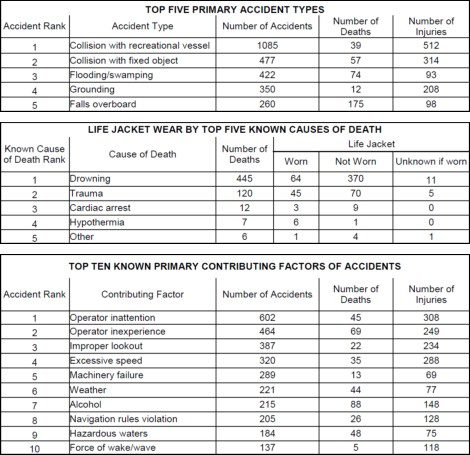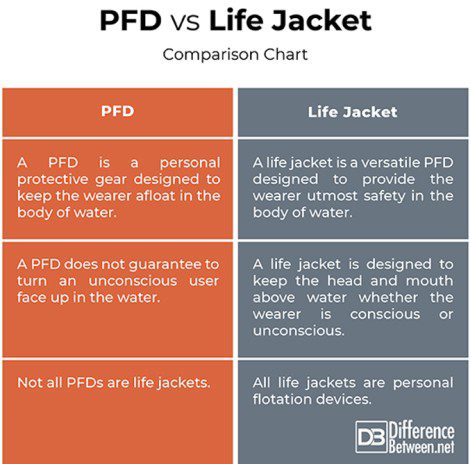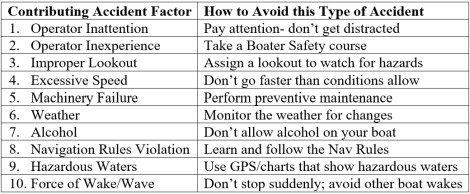 By Bob Currie, Recreational Boating Safety Specialist
By Bob Currie, Recreational Boating Safety Specialist
U. S. Coast Guard Auxiliary Station Galveston Flotilla
The 2022 Recreational Boating Statistics are in. One good note: the fatality rate was down 1.8% from 2021. Another good note: the number of accidents decreased by 9.0% and the number of injuries decreased by 15.9%. Let’s look at the tables below and discuss how they relate.

Accident Type: Collision with Recreational Vessel
This accident type resulted in the greatest number of injuries, as shown in the Accident Type table. That is going to be attributed to Trauma, of course. The number of deaths are linked to Drowning and Trauma in the Life Jacket Wear by Top Known Causes of Death table. People get thrown from the boat, and if they aren’t wearing a life jacket their death is most likely due to a combination of drowning and trauma. Why did they collide with another vessel? Looking at the third table we see the four top contributing factors as the likely cause: Operator Inattention, Operator Inexperience, Improper Lookout, and Excessive Speed. Alcohol is also a likely contributing factor to running into another boat. Toss in crowded waters and you have all the makings of a collision. This accident type can usually be avoided by following the Rules of the Road, even if a drunk idiot is heading toward your boat. In drivers ed we were taught the two second rule to be used in keeping distance between you and the car ahead. On the water a better rule of thumb might be a ten second rule in order to give you more time to escape from a possible collision. At 30 mph ten seconds separation would be 440 feet or about 1.5 football field lengths. A note for the big boats: Autopilot is wonderful for long trips, but placing your boat in Autopilot does not relieve you of having a proper lookout, and Autopilots will run you into a jetty in a heartbeat. It’s just holding course.
Accident Type: Collision with a Fixed Object
Oh yes, people run into stuff that can’t possibly get out of their way all the time. Just look at any dock and note the results of being struck by boats either trying to dock or not paying attention. Our navigation buoys all bear strike marks on them, although commercial vessels are more likely to be the striking vessel. For you anglers I have just one word: Jetty. We have jetties jutting miles out into the Gulf of Mexico. People hit the Galveston jetties on a nearly daily basis. We don’t shift them around at night. They are in a fixed location. All the factors mentioned above apply to this accident type, too. When you strike a fixed object there is a high probability that you and your passengers will be ejected from the boat. Those without PFDs are likely to drown as the force of the ejection coupled with the ensuing trauma often knocks the person out. You are more likely to die from a collision with a fixed object than you would from a collision with another vessel. Fixed objects don’t usually budge; therefore, you and your vessel absorb all the energy of impact. Trauma and Drowning are the most likely cause of death.
Accident Type: Flooding/Swamping
How on earth do we get into a situation such as this? One of the most frequent calls we get are from recreational boats taking on water. Where is that water coming from?
- Holes in the hull due to striking an underwater object near the surface
- Leaks in the hull due to loose through hull fittings
- Waves higher than the boat was designed to take (weather)
- Pitchpoling into a wave (bow goes under the surface)
- Forgot to put in the drain plug (happens more than you think)
- Stopping suddenly with water coming over the transom as a result
- Overloaded boat
- Weight improperly distributed
- Wake or wave from another boat
The most likely contributing factors are Operator Inexperience, Weather (sea state due to winds), and Hazardous Waters. Inboard and inboard outboard boats both have through the hull fittings in order to use sea water for engine cooling. If not properly cared for, those fittings will leak enough to swamp the boat. Flooding/swamping deaths can be attributed almost solely to drowning combined with no PFD worn. As you are sinking is no time to look for a life jacket. You might be able to hold onto a life jacket, but it is very difficult to put one on while you are in the water. Note that as boats fill with water they have a tendency to roll over, and can strike a person on the head or trap them beneath the boat.
Accident Type: Grounding
Grounding also results in ejection of the operator and passengers. Trauma and Drowning are the main causes of death in this category. Operator inexperience would be the leading contributing cause. You have got to know and respect the hazards in the waters in which you operate. Use a GPS with up to date charting and avoid shallow water and shoals.
Accident Type: Falls Overboard
This category has the highest number of deaths. Your passenger falls overboard and is chewed up by the propeller or isn’t wearing a life jacket and drowns. Keep in mind that at 30 mph you are moving 44 feet per second. In a 21-foot boat in less than half a second you will have chopped up your passenger who falls overboard from the bow. You must make sure your passengers are properly seated and are instructed to remain seated while the boat is moving. Operator Inexperience plus alcohol are most often involved in these types of accidents. Allowing your passengers to ride on the bow instead of in a seat is one of the most ticketed violations, and with good reason: your chance of surviving falling overboard while riding the bow is low.
How Can You Drown While Wearing a PFD?
If you look at the statistics, you will note that under the category of Drowning there were 84 drowning deaths of people who were wearing a life jacket. Some of these deaths can be attributed to the type of PFD or life jacket worn by an unconscious person:

Although PFD and Life Jacket are often used to mean the same thing, there is a difference. Type I offshore life jackets are designed to hold the wearer’s head and mouth above water. This is done through the use of more inflatable material coupled with a neck collar that keeps the head of an unconscious person from rolling forward into the water. Without this type of life jacket an unconscious person could drown while wearing another type of PFD.
How to Enhance Your Survivability on the Water
So far we have discussed the five primary accident types, the top five known causes of death, and the top ten contributing factors of accidents. If you wish to enhance your chances of surviving an outing on the water, then I recommend you see the following doctor:
Me: Doctor, it hurts when I do this
Doctor: Don’t do that

The main key is to learn how to be a responsible boater and live up to the Rules of the Road.
Summary
The purpose of compiling accident statistics and analyzing them is to learn what bad habits are causing recreational boating accidents, which cause death, injury, and damage, and to try to get boaters to avoid those bad habits. We have had some success in this regard over the last couple of years, and we are thankful for the improvements made. But the fact is we had a lot of recreational boaters who did not make it home in one piece:
- We had 4,040 reported accidents in 2022
- We had 636 deaths
- We had 2222 injuries
- We had $63 million in damages
If only we could borrow Smokey Bear so he could say, “Only YOU can prevent recreational boating accidents!”
[BC: July-11-2023]

 Posted in
Posted in 























